child lock FORD E SERIES 2003 4.G Owners Manual
[x] Cancel search | Manufacturer: FORD, Model Year: 2003, Model line: E SERIES, Model: FORD E SERIES 2003 4.GPages: 232, PDF Size: 3.4 MB
Page 8 of 232
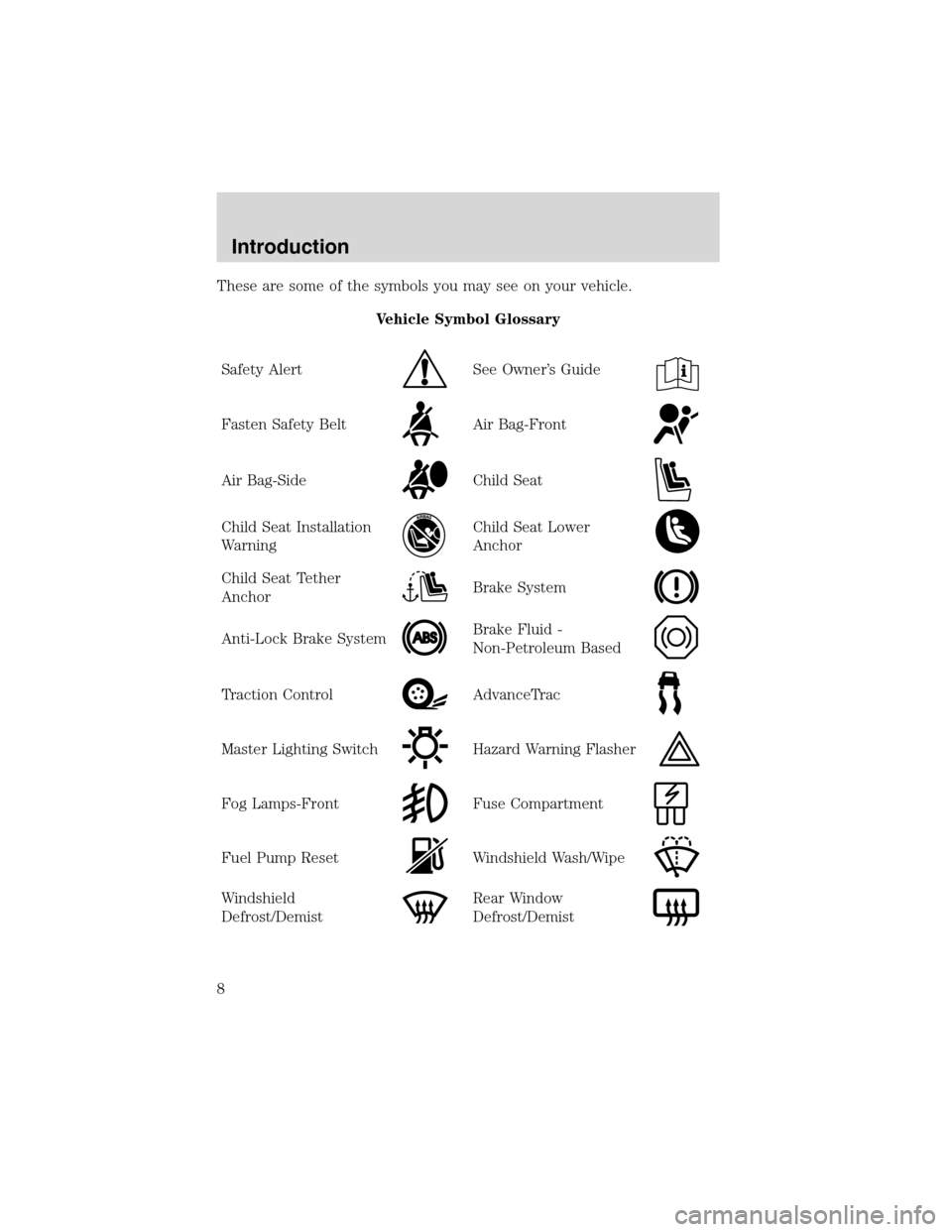
These are some of the symbols you may see on your vehicle.
Vehicle Symbol Glossary
Safety Alert
See Owner’s Guide
Fasten Safety BeltAir Bag-Front
Air Bag-SideChild Seat
Child Seat Installation
WarningChild Seat Lower
Anchor
Child Seat Tether
AnchorBrake System
Anti-Lock Brake SystemBrake Fluid -
Non-Petroleum Based
Traction ControlAdvanceTrac
Master Lighting SwitchHazard Warning Flasher
Fog Lamps-FrontFuse Compartment
Fuel Pump ResetWindshield Wash/Wipe
Windshield
Defrost/DemistRear Window
Defrost/Demist
Introduction
8
Page 9 of 232
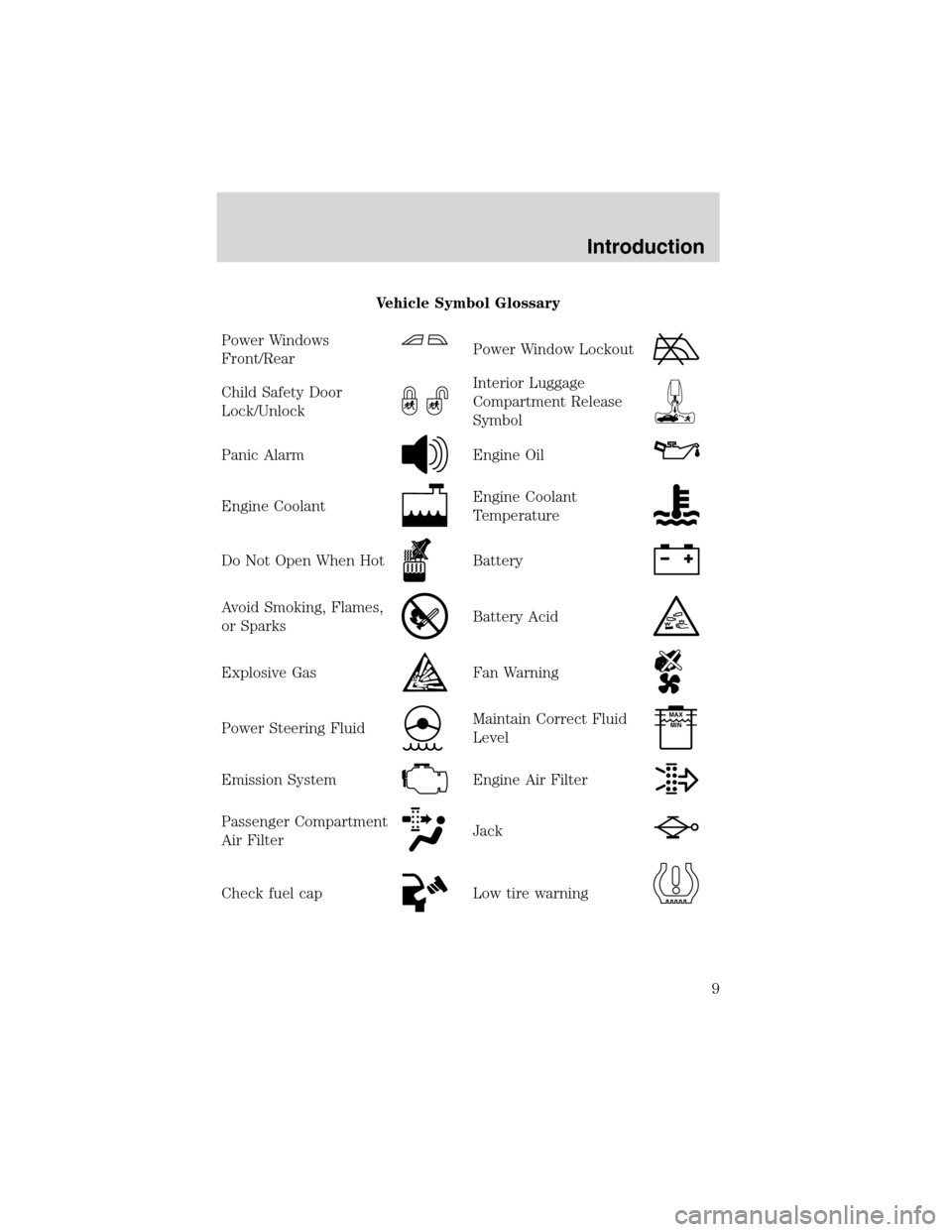
Vehicle Symbol Glossary
Power Windows
Front/Rear
Power Window Lockout
Child Safety Door
Lock/UnlockInterior Luggage
Compartment Release
Symbol
Panic AlarmEngine Oil
Engine CoolantEngine Coolant
Temperature
Do Not Open When HotBattery
Avoid Smoking, Flames,
or SparksBattery Acid
Explosive GasFan Warning
Power Steering FluidMaintain Correct Fluid
LevelMAX
MIN
Emission SystemEngine Air Filter
Passenger Compartment
Air FilterJack
Check fuel capLow tire warning
Introduction
9
Page 57 of 232
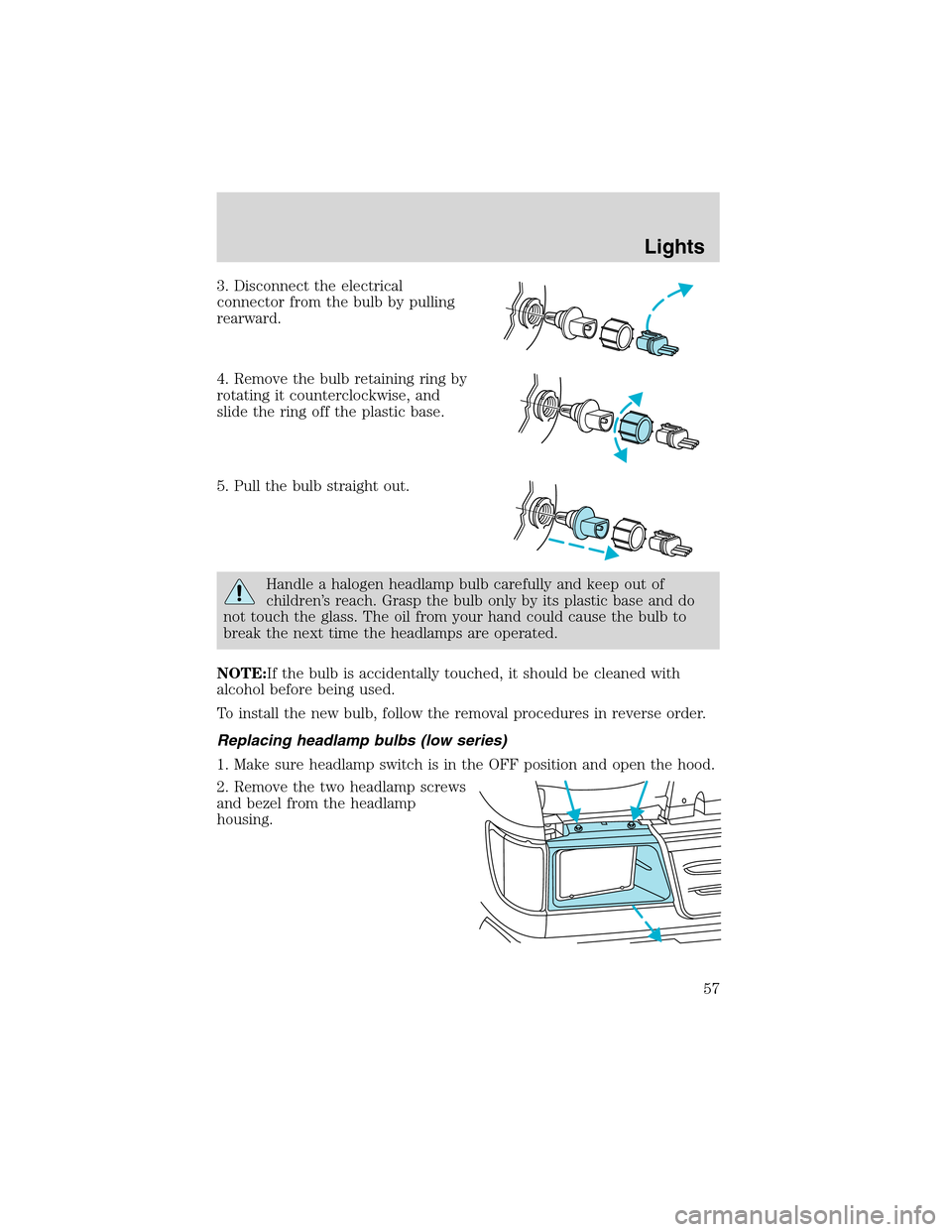
3. Disconnect the electrical
connector from the bulb by pulling
rearward.
4. Remove the bulb retaining ring by
rotating it counterclockwise, and
slide the ring off the plastic base.
5. Pull the bulb straight out.
Handle a halogen headlamp bulb carefully and keep out of
children’s reach. Grasp the bulb only by its plastic base and do
not touch the glass. The oil from your hand could cause the bulb to
break the next time the headlamps are operated.
NOTE:If the bulb is accidentally touched, it should be cleaned with
alcohol before being used.
To install the new bulb, follow the removal procedures in reverse order.
Replacing headlamp bulbs (low series)
1. Make sure headlamp switch is in the OFF position and open the hood.
2. Remove the two headlamp screws
and bezel from the headlamp
housing.
Lights
57
Page 83 of 232
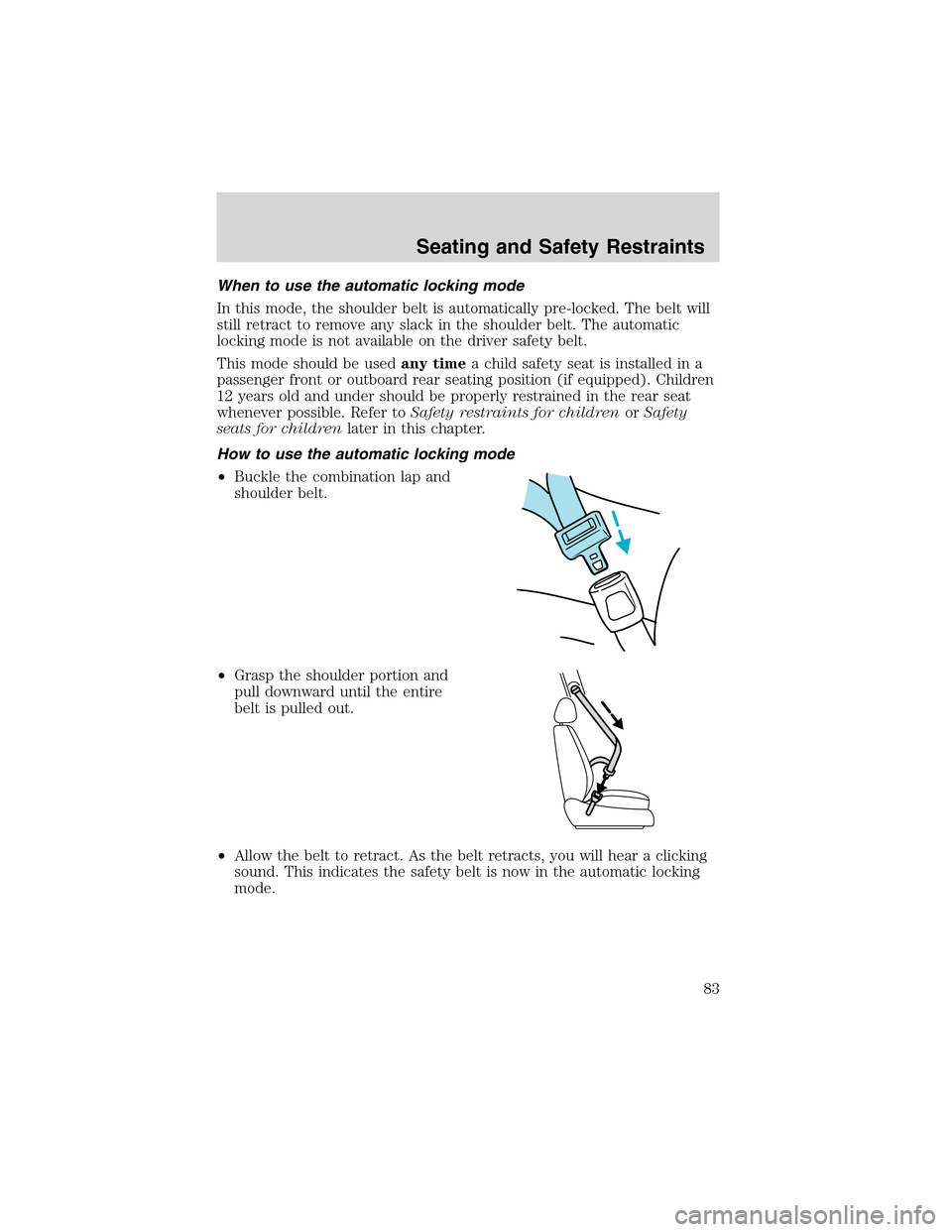
When to use the automatic locking mode
In this mode, the shoulder belt is automatically pre-locked. The belt will
still retract to remove any slack in the shoulder belt. The automatic
locking mode is not available on the driver safety belt.
This mode should be usedany timea child safety seat is installed in a
passenger front or outboard rear seating position (if equipped). Children
12 years old and under should be properly restrained in the rear seat
whenever possible. Refer toSafety restraints for childrenorSafety
seats for childrenlater in this chapter.
How to use the automatic locking mode
•Buckle the combination lap and
shoulder belt.
•Grasp the shoulder portion and
pull downward until the entire
belt is pulled out.
•Allow the belt to retract. As the belt retracts, you will hear a clicking
sound. This indicates the safety belt is now in the automatic locking
mode.
Seating and Safety Restraints
83
Page 84 of 232

How to disengage the automatic locking mode
Disconnect the combination lap/shoulder belt and allow it to retract
completely to disengage the automatic locking mode and activate the
vehicle sensitive (emergency) locking mode.
After any vehicle collision, the safety belt systems at all outboard
seating positions (except the driver position, which does not
have this feature) must be checked by a qualified technician to verify
that the automatic locking retractor feature for child seats is still
functioning properly. In addition, all seat belts should be checked for
proper function.
BELT AND RETRACTOR ASSEMBLY MUST BE REPLACED if
the seat belt assembly“automatic locking retractor”feature or
any other seat belt function is not operating properly when checked
according to the procedures in Workshop Manual. Failure to replace
the Belt and Retractor assembly could increase the risk of injury in
collisions.
Safety belt pretensioner
Your vehicle is equipped with safety belt pretensioners at the driver and
front passenger seating positions.
The safety belt pretensioner is a device which removes excess webbing
from the safety belt system. The safety belt pretensioner uses the same
crash sensor system as the front air bag supplemental restraint system
(SRS). When the safety belt pretensioner deploys, webbing from the lap
and shoulder belt is tightened. The driver and front passenger seat belt
system (including retractors, buckles and height adjusters) must be
replaced if the vehicle is involved in a collision that results in
deployment of front air bags and safety belt pretensioners. Refer to the
Safety belt maintenancesection in this chapter.
Failure to replace the safety belt assembly under the above
conditions could result in severe personal injuries in the event of
a collision.
Seating and Safety Restraints
84
Page 100 of 232
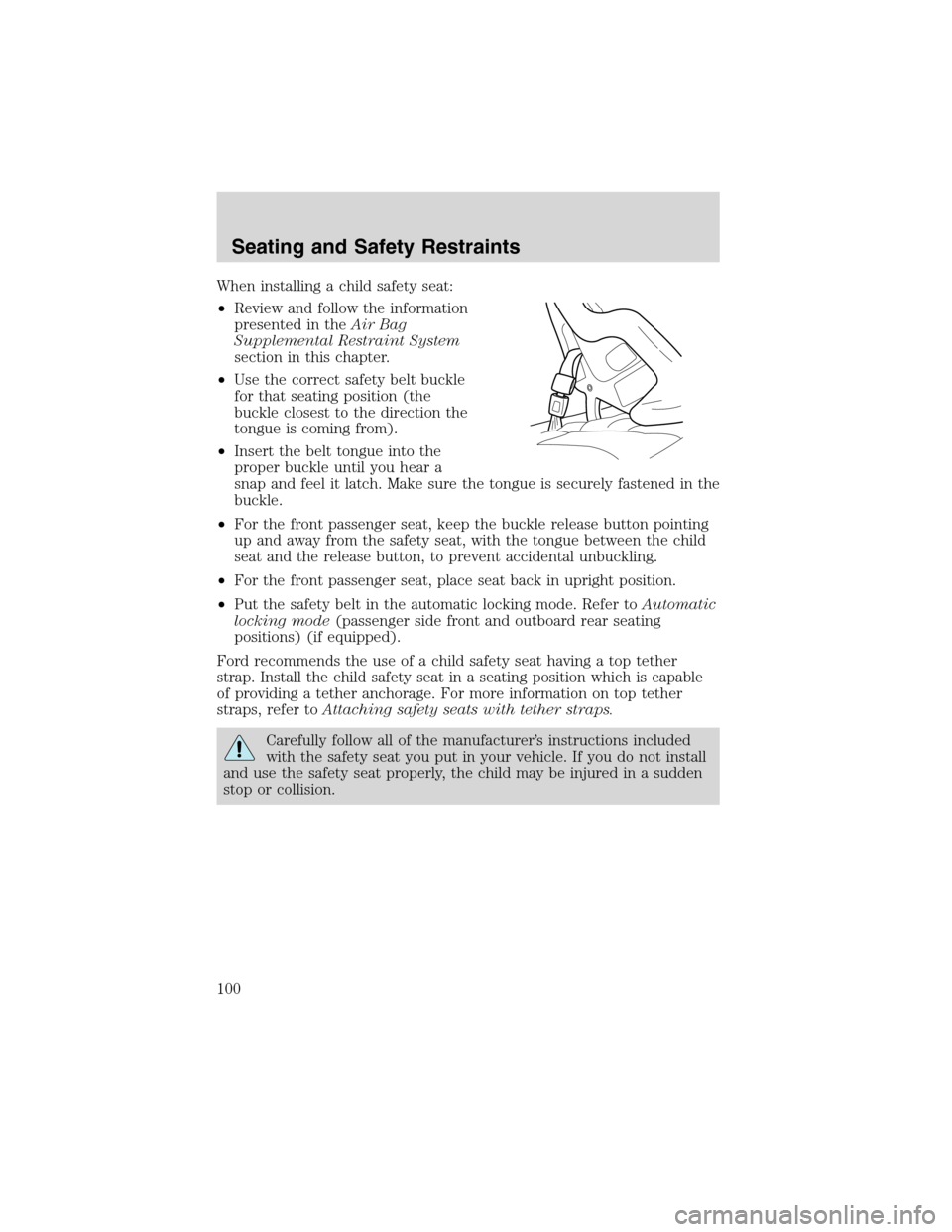
When installing a child safety seat:
•Review and follow the information
presented in theAir Bag
Supplemental Restraint System
section in this chapter.
•Use the correct safety belt buckle
for that seating position (the
buckle closest to the direction the
tongue is coming from).
•Insert the belt tongue into the
proper buckle until you hear a
snap and feel it latch. Make sure the tongue is securely fastened in the
buckle.
•For the front passenger seat, keep the buckle release button pointing
up and away from the safety seat, with the tongue between the child
seat and the release button, to prevent accidental unbuckling.
•For the front passenger seat, place seat back in upright position.
•Put the safety belt in the automatic locking mode. Refer toAutomatic
locking mode(passenger side front and outboard rear seating
positions) (if equipped).
Ford recommends the use of a child safety seat having a top tether
strap. Install the child safety seat in a seating position which is capable
of providing a tether anchorage. For more information on top tether
straps, refer toAttaching safety seats with tether straps.
Carefully follow all of the manufacturer’s instructions included
with the safety seat you put in your vehicle. If you do not install
and use the safety seat properly, the child may be injured in a sudden
stop or collision.
Seating and Safety Restraints
100
Page 102 of 232

3. While holding the shoulder and
lap belt portions together, route the
tongue through the child seat
according to the child seat
manufacturer’s instructions. Be sure
the belt webbing is not twisted.
4. Insert the belt tongue into the
proper buckle (the buckle closest to
the direction the tongue is coming
from) for that seating position until
you hear a snap and feel the latch
engage. Make sure the tongue is
latched securely by pulling on it.
5. To put the retractor in the
automatic locking mode, grasp the
shoulder portion of the belt and pull
downward until all of the belt is
extracted.
6. Allow the belt to retract. The belt will click as it retracts to indicate it
is in the automatic locking mode.
Seating and Safety Restraints
102
Page 103 of 232
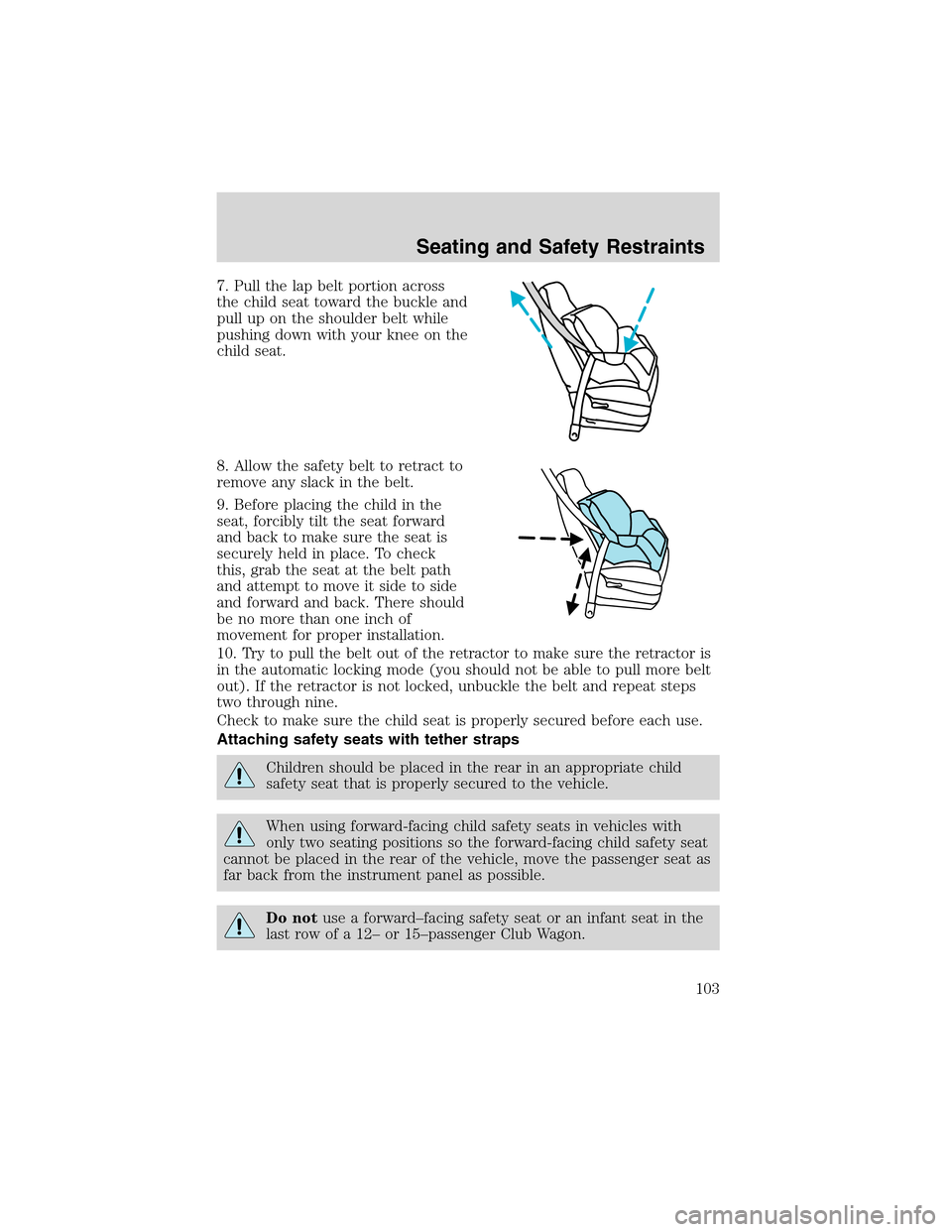
7. Pull the lap belt portion across
the child seat toward the buckle and
pull up on the shoulder belt while
pushing down with your knee on the
child seat.
8. Allow the safety belt to retract to
remove any slack in the belt.
9. Before placing the child in the
seat, forcibly tilt the seat forward
and back to make sure the seat is
securely held in place. To check
this, grab the seat at the belt path
and attempt to move it side to side
and forward and back. There should
be no more than one inch of
movement for proper installation.
10. Try to pull the belt out of the retractor to make sure the retractor is
in the automatic locking mode (you should not be able to pull more belt
out). If the retractor is not locked, unbuckle the belt and repeat steps
two through nine.
Check to make sure the child seat is properly secured before each use.
Attaching safety seats with tether straps
Children should be placed in the rear in an appropriate child
safety seat that is properly secured to the vehicle.
When using forward-facing child safety seats in vehicles with
only two seating positions so the forward-facing child safety seat
cannot be placed in the rear of the vehicle, move the passenger seat as
far back from the instrument panel as possible.
Do notuse a forward–facing safety seat or an infant seat in the
last row of a 12–or 15–passenger Club Wagon.
Seating and Safety Restraints
103
Page 227 of 232
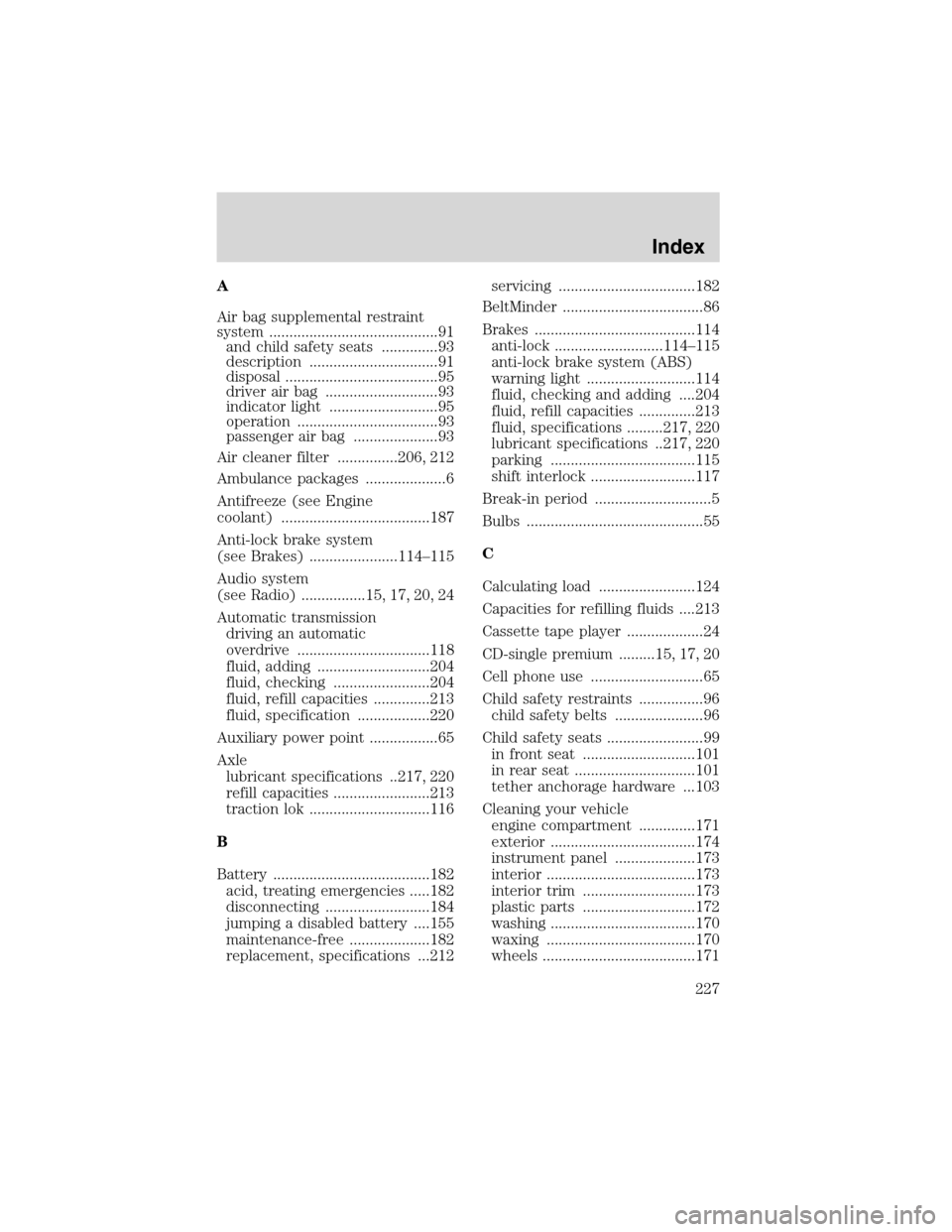
A
Air bag supplemental restraint
system ..........................................91
and child safety seats ..............93
description ................................91
disposal ......................................95
driver air bag ............................93
indicator light ...........................95
operation ...................................93
passenger air bag .....................93
Air cleaner filter ...............206, 212
Ambulance packages ....................6
Antifreeze (see Engine
coolant) .....................................187
Anti-lock brake system
(see Brakes) ......................114–115
Audio system
(see Radio) ................15, 17, 20, 24
Automatic transmission
driving an automatic
overdrive .................................118
fluid, adding ............................204
fluid, checking ........................204
fluid, refill capacities ..............213
fluid, specification ..................220
Auxiliary power point .................65
Axle
lubricant specifications ..217, 220
refill capacities ........................213
traction lok ..............................116
B
Battery .......................................182
acid, treating emergencies .....182
disconnecting ..........................184
jumping a disabled battery ....155
maintenance-free ....................182
replacement, specifications ...212servicing ..................................182
BeltMinder ...................................86
Brakes ........................................114
anti-lock ...........................114–115
anti-lock brake system (ABS)
warning light ...........................114
fluid, checking and adding ....204
fluid, refill capacities ..............213
fluid, specifications .........217, 220
lubricant specifications ..217, 220
parking ....................................115
shift interlock ..........................117
Break-in period .............................5
Bulbs ............................................55
C
Calculating load ........................124
Capacities for refilling fluids ....213
Cassette tape player ...................24
CD-single premium .........15, 17, 20
Cell phone use ............................65
Child safety restraints ................96
child safety belts ......................96
Child safety seats ........................99
in front seat ............................101
in rear seat ..............................101
tether anchorage hardware ...103
Cleaning your vehicle
engine compartment ..............171
exterior ....................................174
instrument panel ....................173
interior .....................................173
interior trim ............................173
plastic parts ............................172
washing ....................................170
waxing .....................................170
wheels ......................................171
Index
227
Page 230 of 232
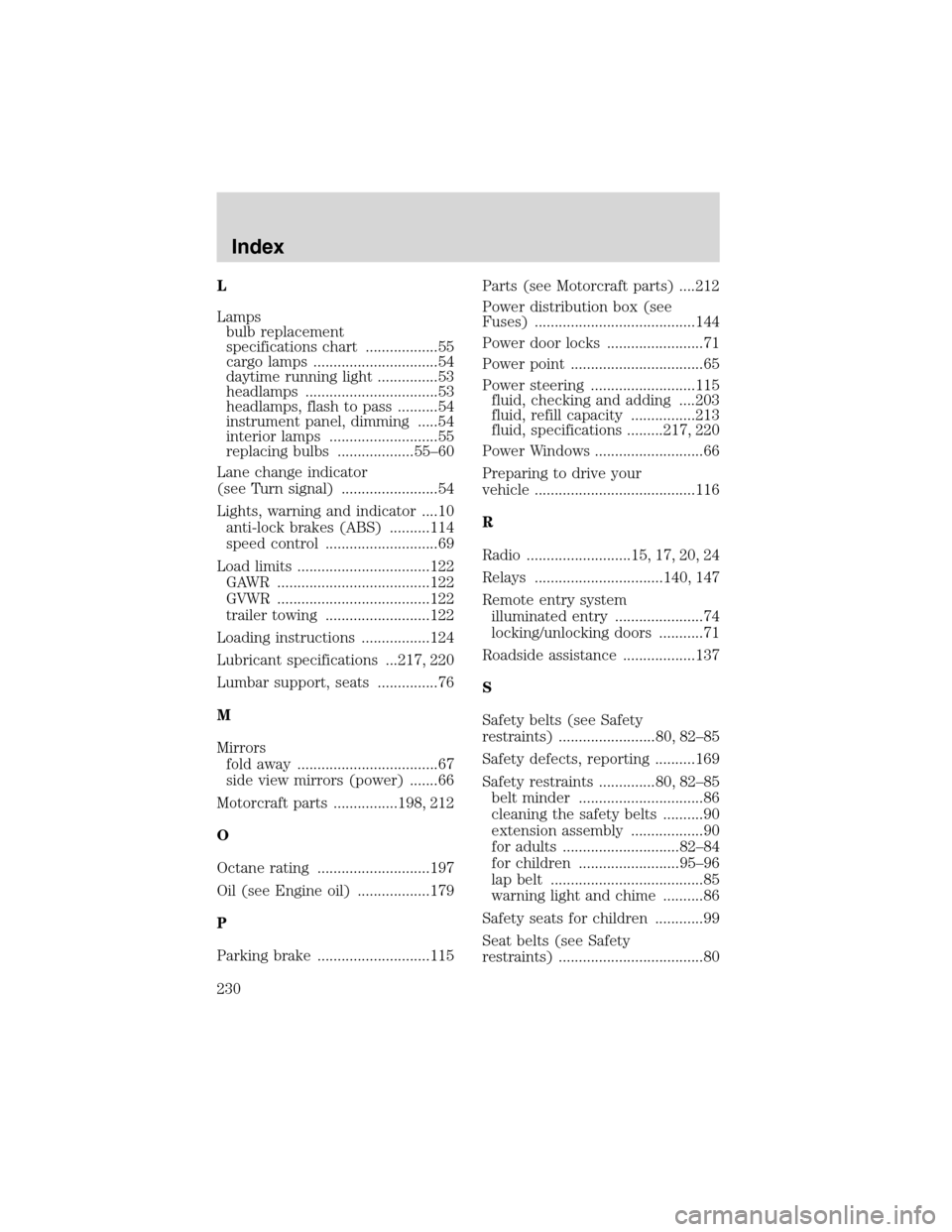
L
Lamps
bulb replacement
specifications chart ..................55
cargo lamps ...............................54
daytime running light ...............53
headlamps .................................53
headlamps, flash to pass ..........54
instrument panel, dimming .....54
interior lamps ...........................55
replacing bulbs ...................55–60
Lane change indicator
(see Turn signal) ........................54
Lights, warning and indicator ....10
anti-lock brakes (ABS) ..........114
speed control ............................69
Load limits .................................122
GAWR ......................................122
GVWR ......................................122
trailer towing ..........................122
Loading instructions .................124
Lubricant specifications ...217, 220
Lumbar support, seats ...............76
M
Mirrors
fold away ...................................67
side view mirrors (power) .......66
Motorcraft parts ................198, 212
O
Octane rating ............................197
Oil (see Engine oil) ..................179
P
Parking brake ............................115Parts (see Motorcraft parts) ....212
Power distribution box (see
Fuses) ........................................144
Power door locks ........................71
Power point .................................65
Power steering ..........................115
fluid, checking and adding ....203
fluid, refill capacity ................213
fluid, specifications .........217, 220
Power Windows ...........................66
Preparing to drive your
vehicle ........................................116
R
Radio ..........................15, 17, 20, 24
Relays ................................140, 147
Remote entry system
illuminated entry ......................74
locking/unlocking doors ...........71
Roadside assistance ..................137
S
Safety belts (see Safety
restraints) ........................80, 82–85
Safety defects, reporting ..........169
Safety restraints ..............80, 82–85
belt minder ...............................86
cleaning the safety belts ..........90
extension assembly ..................90
for adults .............................82–84
for children .........................95–96
lap belt ......................................85
warning light and chime ..........86
Safety seats for children ............99
Seat belts (see Safety
restraints) ....................................80
Index
230